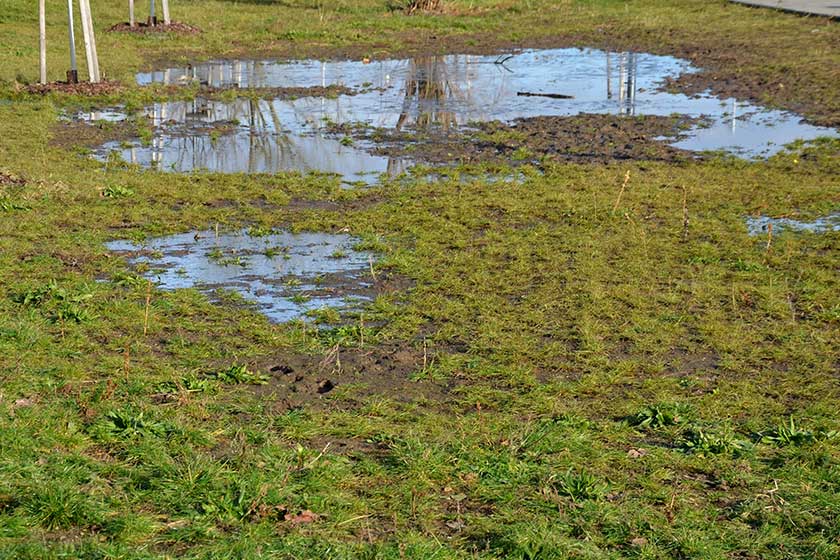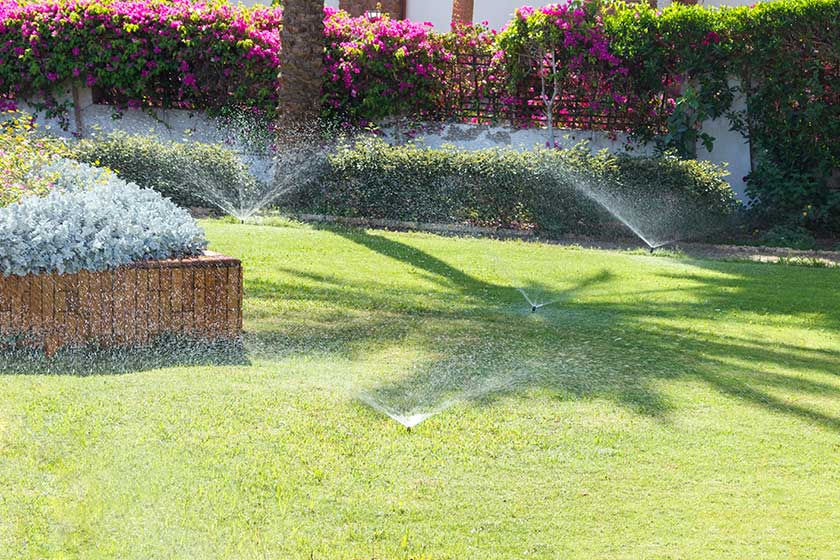Winter brings many challenges to homeowners, and one of the most frustrating is dealing with a muddy lawn. The colder months can create puddles, soft patches, and muddy areas on your property. This makes it difficult to maintain a clean and neat yard.
Knowing how to fix a muddy lawn in winter is important for homeowners who want to keep their outdoor spaces looking inviting and well-kept.
Assess the Extent of Damage to Your Lawn First
Before taking any action, it is important to assess how much damage has been done to your lawn. Start by checking the depth and spread of the mud. If the ground is soft and saturated in multiple areas, it’s important to figure out where water has collected and how large the affected zones are.
Look for signs like grass thinning or areas where the soil has been compacted. This will help you determine whether the problem is due to poor drainage, frequent foot traffic, or both. Knowing the scope of the issue makes it easier to decide the most appropriate treatment plan.
Once you’ve identified the problem areas, take note of how often they stay wet. If the lawn remains muddy long after it rains, it may indicate a larger drainage issue. The information will be helpful when applying more targeted solutions to fix the muddy lawn and prevent further damage.
Identify the Main Causes of Muddy Lawn Issues
The next step is to pinpoint the causes behind the muddy lawn. Various factors contribute to a lawn becoming muddy during winter. Compacted soil is one of the leading causes. This makes it difficult for water to drain properly. When soil becomes dense and tightly packed, water tends to pool on the surface, creating muddy conditions.
Another factor is poor lawn care practices, such as heavy foot traffic, which can also cause compaction. The weight of constant movement on wet ground can damage the grass and make the soil even more compact. Poor drainage systems in your yard are another common cause of water accumulation.
In some cases, a muddy lawn is simply the result of excessive rainfall or snowmelt that your lawn isn’t equipped to handle. This can often happen in areas where the land is not level and allows water to settle in low spots.
The grass may struggle to grow in these areas because it cannot get the necessary nutrients. The mud creates a barrier that further hinders growth. Identifying the root cause will direct you to the most effective method for fixing the muddy lawn.
Improve Drainage to Prevent Water Accumulation
One of the best ways to fix a muddy lawn in winter is by improving drainage. Without proper drainage, water will continue to pool and create muddy patches throughout your yard.
Start by assuring that your yard has a slope that directs water away from the lawn and toward a designated drainage area. If your lawn is flat or has low spots where water collects, consider installing a French drain or surface drain to redirect the water flow. These systems will help the water move away from your yard. This prevents it from lingering and causing muddy conditions.
Another way to improve drainage is by aerating the lawn. Aeration comprises poking holes in the soil to allow air, water, and nutrients to reach the grassroots. This can alleviate soil compaction and promote better water movement–reducing the chances of your lawn becoming overly saturated.
Aeration should be done before the ground freezes. This can improve drainage and reduce the risk of mud in future winters. Taking these steps to improve drainage can significantly reduce the risk of muddy patches in your lawn.
Use Sand to Level and Stabilize the Surface
If the ground is uneven or prone to muddy spots, using sand can help level and stabilize the surface. Sand is an effective material to apply to compacted soil. It helps break up dense areas and allows for better water absorption.
Spread a thin layer of sand over the affected areas and work it into the soil using a rake or shovel. The sand will help loosen the soil. This creates a better environment for grass to grow and reduces the likelihood of mud accumulating in the future.
Once the sand is applied, follow up with proper watering to help the sand settle into the soil. This can improve the overall structure of the ground and make it more resistant to compaction.
Over time, the soil will become better at absorbing water and reduce the number of muddy areas during the colder months. Using sand is a simple and cost-effective solution for homeowners who want to stabilize their lawns and prevent further damage during winter.
Apply Compost to Enhance Soil Structure Naturally
Another effective way to fix a muddy lawn in winter is by applying compost.
Compost is rich in organic material that can help improve soil structure and enhance its ability to drain water. When applied to muddy areas, compost helps break up heavy, compacted soil. This allows better water infiltration and reduces puddling. It also provides key nutrients that promote grass growth and help restore the health of your lawn. Spread a thin layer of compost over the affected areas and rake it into the soil for better coverage.
Using compost as a natural soil conditioner also increases the microbial activity in the soil–which helps break down organic matter and improves soil aeration. This reduces compaction over time and allows grassroots to grow deeper and stronger. As a result, your lawn becomes more resilient against future winter conditions.
Regular use of compost, especially during colder months, can lead to better drainage and a healthier, more robust lawn overall.
Install French Drains for Long-Term Water Control
Installing French drains is a highly effective way to control water in areas prone to flooding or pooling. French drains are specially designed systems that channel excess water away from your lawn. This prevents it from accumulating and causing muddy conditions.
These drains consist of a perforated pipe placed in a trench filled with gravel. When water collects in the trench, it flows through the perforated pipe and is redirected away from the lawn. This helps prevent water from sitting on the surface and reduces the chances of your lawn becoming waterlogged and muddy.
French drains offer long-term solutions for managing water flow, particularly in yards that experience frequent rainfall or snowmelt. Installing them might require a bit of work, but once in place, they provide lasting benefits by assuring that excess water is properly directed away from your lawn.
For homeowners dealing with significant water issues, French drains are an excellent investment for preventing muddy lawns during winter and beyond.
Plant Grass Seed Suitable for Cold Weather Conditions
Another way to address a muddy lawn is by planting grass seed that is suitable for cold weather conditions. Cold-tolerant grasses, such as fescue, ryegrass, or bluegrass, are well-suited to grow in cooler climates. They can help establish a healthier lawn that’s less prone to becoming muddy.
Choose grass varieties that are designed to thrive in your region’s climate to assure successful growth even during winter months. Cold-weather grasses have deep roots that allow them to better absorb water and prevent excess moisture from accumulating on the surface.
When planting, make sure the ground is properly prepared by aerating the soil and removing any debris. Plant the seed evenly. Water it gently to keep the soil moist but not overly saturated.
You can create a more resilient lawn that won’t turn into a muddy mess during the colder months by selecting the right type of grass seed and maintaining it properly. This is an effective long-term strategy for homeowners looking to maintain a healthy and attractive lawn throughout the year.
Add Mulch to Protect Soil from Erosion and Cold
Mulch serves as an excellent protective layer for soil, especially during the cold winter months. Adding a layer of mulch around your lawn helps prevent soil erosion and protects the underlying grass from freezing temperatures.
Mulch acts as an insulating barrier–keeping the soil temperature more stable and reducing the chances of frost damage to your grass. It also prevents rain and snow from washing away valuable topsoil. This can contribute to muddy conditions.
In addition to its protective properties, mulch helps retain moisture in the soil, which is beneficial for grass health, especially when the ground tends to dry out during winter. Use organic mulch, such as wood chips or shredded leaves, as they break down over time and add nutrients to the soil.
Apply a thin layer of mulch around your lawn, with a focus on areas that are particularly prone to erosion or muddy patches. With mulch, you can help protect your lawn and prevent further issues related to soil erosion or excessive moisture accumulation.
Use Gravel or Stones for High-Traffic Pathways
If certain areas of your lawn experience consistent foot traffic, consider using gravel or stones to create durable pathways. These materials are perfect for managing high-traffic zones. They allow water to drain freely while preventing the formation of mud.
Gravel and stones are ideal for walkways, driveways, or any area where people frequently walk, especially during the wet winter months. You can stabilize the surface and prevent further erosion by placing a layer of gravel or decorative stones.
Installing gravel or stones in these high-traffic areas also presents a long-lasting solution to muddy problems. The stones create a firm surface and guarantee that water moves through easily without pooling.
In addition, they help protect the underlying soil from compaction–a common cause of waterlogging and muddy conditions. If you want to maintain a functional yet aesthetically pleasing lawn, gravel or stones are excellent options to protect it from excessive wear and tear.
Aerate the Soil to Improve Oxygen and Water Flow
Aerating the soil is one of the most effective ways to address compaction and improve the overall health of your lawn. When the soil is compacted, water, air, and nutrients have a harder time reaching the grass roots. As a result, it is more likely for your lawn to become muddy.
Aeration involves perforating the soil with small holes to allow a better flow of water and oxygen to the roots. This not only improves the soil structure but also promotes better root growth and healthier grass.
To aerate your lawn, you can use a manual or mechanical aerator. Aeration is best done during the fall or early spring before the ground freezes to assure maximum effectiveness.
You can prevent future compaction, reduce muddy patches, and encourage deeper grass growth by aerating your lawn regularly. This is a simple yet powerful step toward maintaining a beautiful, mud-free lawn during winter and throughout the year.
Muddy Lawn Solutions Nashville: Contact Covenant Landscapes Today
Learning how to fix a muddy lawn in winter can leave your property looking untidy and uninviting. It’s time to take action and restore your yard to its full potential with the right muddy lawn solutions in Nashville.
With our expertise at Covenant Landscapes, we offer tailored solutions that address your lawn’s unique needs. From enhancing soil structure to implementing proper drainage, we provide everything your lawn requires to stay healthy, even in the coldest months.
As a trusted landscape company in Nashville locals choose, we make sure that your lawn thrives no matter the season.


